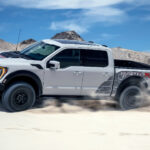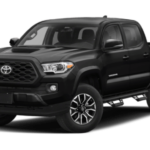The Highlander is more affordable, has lower ownership costs, and is more practical than big 4×4 off-roaders. But can it do mudding and rock- crawling? I’ll discuss Toyota Highlander’s off-road capabilities and upgrades in this article.
A standard Toyota Highlander offers eight inches of ground clearance. It has an all-wheel-drive system and a dynamic and powerful torque. So, if you take it on an off-road trip, it should be capable of handling the not-so-tough ride you will subject it to.
A typical Toyota Highlander is fitted with a Four Wheel Drive (FWD) or an All-Wheel-Drive power train. The AWD can provide additional traction, while the FWD can provide the intelligent capability. Both drive trains are capable of handling not too rough off-road tasks.
Read on to learn more about the capabilities of the Toyota Highlander and the mods and upgrades you need to make it more off-road capable.
Toyota Highlander Off-Road Capabilities and Upgrades

You can take a Toyota Highlander for a light off-road trip.
This vehicle has eight inches of ground clearance. Its drive train is either a four-wheel drive or an all-wheel drive. An available dynamic torque can produce a decent amount of torque to remove its wheels from a not-so-deep mud or hill.
So, indeed, you will be able to hurdle off-road pavements.
If you want extreme off-roading, you must get appropriate mods and upgrade some of its factory specs. A regular one has three rows of seats that comfortably seat up to eight people.
The Toyota Highlander can hold its value even after many years. After five years, a used one can retain 46.3% of its original value. It beats all other SUVs in its class and size.
Those in the know consider the Toyota Handler even better than other Toyota SUV models. The next Toyota vehicle that can beat the Highlander in terms of off-road capabilities is the Toyota RAV 4. However, this vehicle is a lot pricier than the Highlander.
Can the Toyota Highlander Go Off-Road?
In its present factory specs, can you take a Toyota Highlander off-road? If you are honest enough, this vehicle is not designed for daily off-road use. Perhaps, you can use it occasionally on outdoor trips but certainly not on rocky and muddy uphill roads.
It would be best to have mods on the vehicle to make it more off-road capable. However, for occasional outdoor trips, this vehicle can adequately handle itself. Bigger tires are the easiest way you can make it a good off-roader. Lifts can make it even more capable.
That’ll add more ground clearance to its stock ground height. Additionally, installing a bull bar with a winch on the front will make it look ready to take the challenges of the outdoors, even capable of crossing streams and shallow rivers.
Highlander Specs
In its existing factory settings, the Toyota Highlander has the following specifications:
1. Strong Torque
The off-road capability of a vehicle can be gauged by how much low-end torque it can provide. If you want an excellent off-roader, you should look for a low rpm which translates to lots of torque. This will enable your vehicle to give more power to your tires when it’s going slow.
In this respect, the Toyota Highlander has a good and a bad side. On the good side, its engine can deliver 295 horsepower and 263 pound-foot of torque. This engine is solid and powerful.
In some tests, it delivered maximum torque at around 4,700 rpm. However, its downside is that you can’t use all this power at lower speeds.
2. Higher Ground Clearance
Regarding ground clearance, the Toyota Highlander will not be left behind. It has a ground clearance of around 8 inches. It can clear small rocks and bumps. However, traversing larger obstacles is out of the question.
If you want to take your Highlander on a real off-road trip, you should give it a ground clearance of at least 8.8 inches. A 10.8-inch ground clearance will be a lot safer.
For comparison purposes, the regular Jeep Wrangler, a competent off-roader, has a ground clearance of about 9.7 inches.
3. More Powerful Drive Train
The Toyota Highlander comes in two trims, the all-wheel-drive, and the four-wheel-drive. So, it can manage light off-road trips and trails.
However, you won’t enjoy off-roading with your AWD Toyota Highlander, although you can force it to do so. In general, AWD and FWD vehicles can be safely used for trail driving, not legit off-road driving.
4. Bigger Tires
Though there is nothing special with the stock tires of a standard Highlander, they are still bigger than the tires of an average sedan. Every Toyota Highlander that comes from the factory is fitted with 18 x 18 inches tires. They are perfect for highways but not for trails.
If you want to go off-road, you should replace the stock tires with bigger off-road tires. With bigger tires, you can extract all the power and off-road capabilities from your Toyota Highlander.
5. Approach and Departure Angles
You can handle ruts, roots, and dips on the road with a stock Toyota Highlander. In stock form, your Highlander can go downhill without interference. It has an approach angle of around 18 degrees and a departure angle of about 23 degrees.
However, you can’t do serious rock crawling. If you want to go this far, you should mod your Highlander to have a maximum approach or departure angle greater than its existing specs.
Again, are Toyota Highlanders good for off-road? The 2021 Toyota Highlanders’ specs, such as low-end torque, ground clearance, and regular drivetrain, make it excellent for light off-roading.
What Off-road Mods Can You Get for a Highlander?

Although it is not a real off-roader, the Toyota Highlander is built so that you can modify it to become a full-fledged 4×4. What mods and upgrades do your need to install to make it so? Here are some suggestions:
1. Tires
If you want to use it for frequent 4×4 trips, optimize its off-road capabilities. The first factory setting that you must upgrade is its tires.
It would be best to replace its stock tires with wider, flatter ones. They will anchor your Highlander more firmly and give you additional stability while driving on rougher and uneven surfaces.
All-terrain tires are the best if you use your Highlander for your daily drive. A/T tires have better traction in dry, wet, and light snowy roads. They can also provide good traction on the rocks and undulating hills.
The maximum size of tires that you can use on a Highlander is the 245/65/r18s. If you lift your Highlander using a 2-inch read lift SST lift kit, you can fit in up to 265/65/r18 tires.
2. Lift Kit
Raising your Highlander’s ground clearance will make it off-road capable. You can do this easily with a lift kit. To increase the height of your Highlander, you need to equip it with a suspension lift kit. One such lift kit is the one I mentioned above.
If you install this lift kit, your Highlander can easily handle muddy and stony surfaces, aside from successfully going through rocks and hills.
3. Brake Upgrades
You need to upgrade the stock braking system of your Toyota Highlander. In its stock form, using this vehicle in traversing rigorous road conditions is very dangerous. So, you need to upgrade your braking system with stainless steel brake lines.
They can make your brakes come to a halt faster and more responsively. You should also upgrade (if you can) its hydraulic system. They are critical in transmitting the brake pad pressure to the wheels of your vehicle.
4. Grill Guard
The stock grill guard of your Toyota Highlander is enough to protect it from emergencies and accidents. However, if you want to make it a legit off-roader, you should replace its grill guard with tubular steel.
It is made of heavy-duty material that won’t age and gets damaged easily. It would be best to design a grill guard to fit your headlights and not diminish their ability to illuminate during night drives.
5. Roof Rack
A roof rack is not a critical component of a 4×4, but it will make your off-road trips easier and more convenient. You can store your camping or fishing equipment instead of putting them inside the trunk.
That will be easier, more convenient, and safer when you remove your toys and tools and when you need to put them back in place again.
6. Harness
You should not forget your harness if you want an excellent off-road setup. A harness is essential in preventing injuries. Many off-road drivers fall into different kinds of accidents because of the nature of the activity.
Equipping your seats with the appropriate harnesses will ensure that you won’t get hurt if you get into situations where you can get hurt.
What Are the Pros and Cons of Modifying a Toyota Highlander?

Before pursuing this project of making your Toyota Highlander an off-roader, you should consider its pros and cons first.
There are things you can mod in your Highlander that will make it a good off-roader, and then there are things you can do to make it worse. So, here are the pros and cons of this project:
Pros
- It will make it a safer vehicle for off-roading
- It improves its braking system
- It increases the resale value of the vehicle
- It adds up to the lifespan of the vehicle
- It enhances the vehicle’s performance
Cons
- It adds more weight to the already heavy vehicle
- The heavier weight makes it less fuel efficient
In Closing
A regular Toyota Highlander is not designed to be used as an off-roader. In its stock form, it is a competent all-terrain vehicle. It has a ground clearance of 8 inches. It’s an all-wheel-drive system, and dynamic torque can take small hills’ rough and tumble road surfaces.
A typical Toyota Highlander is fitted with a Four Wheel Drive (FWD) or an All-Wheel-Drive power train. If you want additional traction, go for the AWD, but if you need the intelligent capability, the FWD is your choice.
If you do some appropriate mods and upgrades, it will be more capable of handling rougher and tougher off-road pavements and make it more off-road capable.







![Read more about the article Toyota FJ Cruiser Towing Capacity [How Much Weight Can It Tow?]](https://roadsumo.com/wp-content/uploads/2021/05/fj-cruiser-towing-capacity-300x200.jpeg)

![Read more about the article 1st Gen Tacoma Specs and Review [1995-2004 Toyota Tacoma]](https://roadsumo.com/wp-content/uploads/2022/05/1st-gen-Tacoma-300x200.jpg)